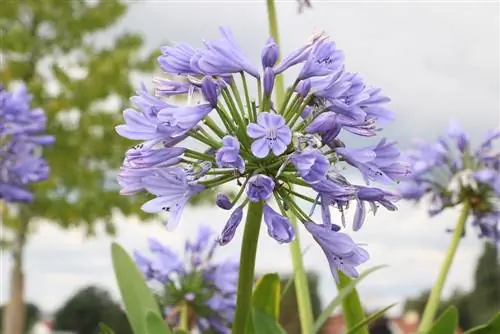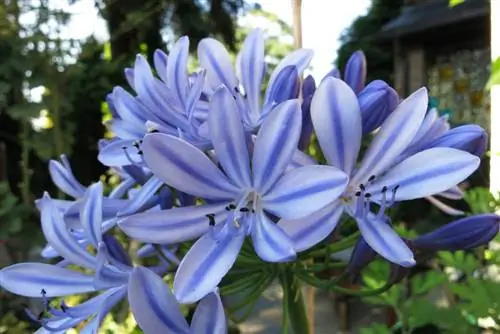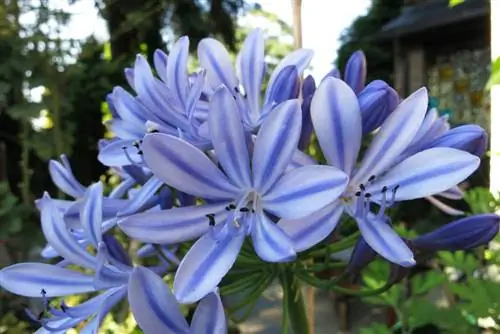- Author admin [email protected].
- Public 2023-12-17 03:39.
- Last modified 2025-01-24 12:45.
The African African lily is also colloquially called the love lily and has the botanical name Agapanthus africanus. The ornamental plant is particularly valued for its beautiful inflorescences, which form in the summer. In this country, however, the love lily can only be planted in a pot because the plant is not frost-hardy due to its origins in Africa. That's why the African African lily needs a special winter quarters in winter in order to survive the cold season unscathed. To ensure lush flowers, additional care units are necessary even in summer.
Location & plant substrate
The African African Lily originally comes from Africa, which is why the sun-drenched plant enjoys a sunny location. Although the love lily thrives in locations that are in the shade all day, the lack of light leads to stunted growth and failure to bloom. The location should not be too exposed, as the long flower stalks can quickly snap off in strong gusts of wind. Due to the rapidly increasing size and extent of the plant, the solitary position of the love lily is recommended. Although the African African lily can be kept as a houseplant, it thrives better outdoors:
- Location should have full sunshine for at least hours
- Partly shaded locations are also accepted, but this reduces the splendor of the flowers
- Warm and sheltered places are ideal
- Cultivation only possible in a bucket
- Set up either on the balcony, terrace or in the garden
- Thrives all year round in the air-conditioned winter garden
- Normal potting soil is sufficient as a plant substrate
- Enrich soil with slow-release fertilizer and sand and clay components
- Fill the lower pot area with expanded clay, lava grit or fine gravel
- Drainage improves water permeability
Watering & Fertilizing
The Agapanthus africanus develops extremely fleshy roots and can therefore survive prolonged drought. It is extremely important that there is good water flow in the planter; it must definitely have holes. In addition, water should never be left standing in the planter, even for a short period of time. During the growing season from spring to autumn, the love lily is grateful for additional fertilization and rewards this with abundant flowering. The following procedure is recommended when watering and fertilizing:
- Watere regularly from April, but not excessively
- Let the top layer of soil dry between watering sessions
- In the winter months, from November to March, irrigation is rarely necessary
- Root area is extremely sensitive and cannot tolerate waterlogging
- Fertilize from the beginning of spring until overwintering
- Administer fertilizer every 2 weeks
- Normal flower fertilizers are completely sufficient
Planters & Repotting
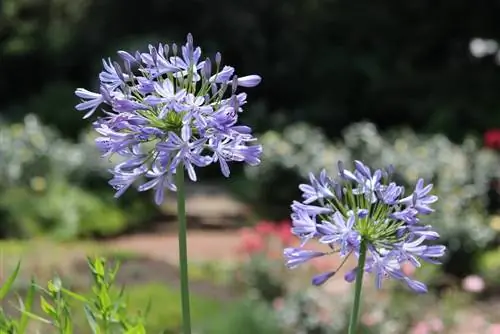
The love lily develops extremely thick roots, which exert considerable pressure on the planter. For this reason, valuable pots should not be used for this plant, because when repotting the root ball can often no longer be removed without destroying the container. Repotting should only be done as rarely as possible, as this causes the African lily to feel extremely stressed. If the plant can grow undisturbed for a long time, it will usually bloom even more profusely. Only when the roots protrude out of the pot or are noticeably growing too densely is it necessary to repot into a larger planter. An extremely compacted root system also means that sufficient water can no longer be absorbed. If the plant grows poorly, this is the first sign that the containers need to be changed:
- Repotting should ideally be done in spring
- Alternatively, repotting is also possible before overwintering
- Can be divided and propagated directly when repotting
- Always pay attention to stable and durable containers
- Optimal planters are wooden pots with robust steel rings
- Pay attention to large drainage holes in the bottom of the container
Tip:
The new container should be only slightly larger than the old container, as the African African lily blooms most beautifully when the container is completely rooted.
Cutting
Agapanthus africanus does not need periodic pruning for thinning, but dead flower stalks should be removed regularly. Otherwise seeds will form and the plant will become lazy to flower. The following aspects should be taken into account when cutting:
- Remove withered flowers with sharp secateurs to encourage flowering
- Tear off withered and dead leaves gently with your fingers
- Flower stems are ideal for cutting vases and stay beautiful for almost two weeks
- Produces either blue, purple or white flowers
- Flowering time is from June to August
- Clusty growth, can reach heights of 80-100 cm
Tip:
The plant sap of the love lily leaves extremely stubborn stains on textiles, so careful handling is highly recommended when cutting.
Wintering
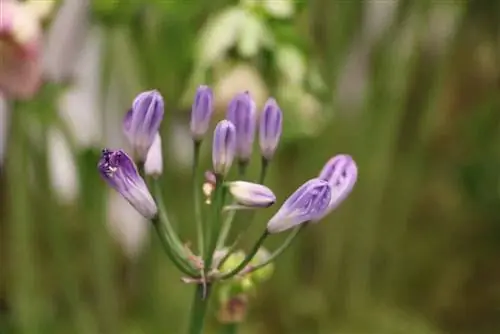
The African African lily is only frost hardy at low temperatures below zero (can tolerate temperatures down to -5° C) and has to move to suitable winter quarters at the end of autumn. A completely frozen root ball will otherwise cause the plant to die. The winter quarters must not be too warm, otherwise the flowers will fail during the following summer months. A few weeks of winter rest are completely sufficient to ensure the next flowering. If you want early sprouting, the container can be moved again to a bright and warm room after a short rest. The following procedure has proven successful during wintering:
- Continuous winter rest is important
- Avoid changes in light and temperature conditions
- A cold room is ideal, no warmer than 10° C
- Deciduous varieties can also tolerate dark winter conditions
- Evergreen varieties need bright locations for overwintering
- Just water a little about once a month, keep almost dry
- Stop fertilizer application completely
- Move back outside as early as possible
- Protect from late frosts in spring
Tip:
Large pots with a heavy plant are best transported to the winter quarters with a sack or wheelbarrow.
Propagate
Over the years, the love lily can reach an impressive size with a massive rootstock, which quickly exceeds the dimensions of the planter. Due to their increasing size, it is advisable to propagate them by division if necessary. In this way, the size and weight of the plant remain manageable and moving to winter quarters is possible without any problems. The following criteria must be observed when propagating:
- First divide the plant carefully into different plant parts
- Divide roots with spade or sharp ax
- Plant separated parts in separate containers
- Ideally divide at the beginning of spring, before the flowers emerge
- Alternatively, sharing is also possible before wintering
- After dividing, make sure there are sufficient pouring units
Diseases & Pests
The African African lily is extremely robust and very resistant to diseases and pests. Rabbits, mice, caterpillars and snails despise the love lily because of the strong plant sap. However, the plant reacts sensitively to errors in care and the wrong location conditions:
- Annoying pests avoid the love lily
- Robust against lice and fungal infestation
- Waterlogging quickly leads to root rot
- Stunty growth and a musty smell from the soil are indications of rotting roots
- Provide the plant with new and dry soil
- Be sure to incorporate drainage into the bucket to avoid waterlogging in advance
- Cut off rotting roots very carefully
Conclusion
The African African lily is an extremely resilient potted plant that does not require particularly much care throughout the year. However, the love lily needs more intensive care to develop the flowers and overwinter so that it can bloom magnificently in the summer and survive the winter without damage. When locating for summer, warm and sunny conditions are extremely important, with protection from strong gusts of wind. In winter you need to rest for a few weeks in a cool and, depending on the variety, either bright or dark room. In this way, the next flower will be particularly magnificent. One of the most common care mistakes is excessive watering, which leads to waterlogging and subsequent root rot in the African lily. Propagation is possible simply by dividing the upper parts of the plant and the rhizome; in this way you can quickly have several love lilies as decoration for balconies, terraces and the garden. Due to its robust properties, the African African lily is not susceptible to diseases and pests.

